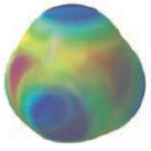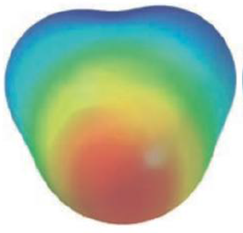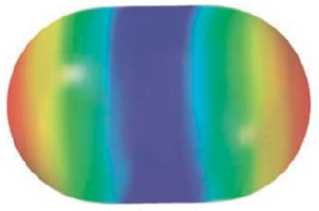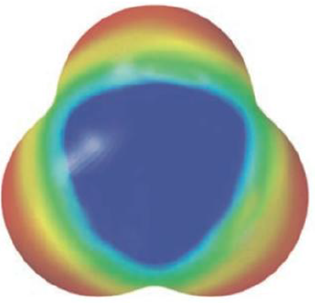
Bundle: Chemistry: An Atoms First Approach, Loose-leaf Version, 2nd + OWLv2 with Student Solutions Manual, 4 terms (24 months) Printed Access Card
2nd Edition
ISBN: 9781337086431
Author: Steven S. Zumdahl, Susan A. Zumdahl
Publisher: Cengage Learning
expand_more
expand_more
format_list_bulleted
Concept explainers
Textbook Question
Chapter 4, Problem 29E
State whether or not each of the following has a permanent dipole moment.
a. 
b. 
c. 
d. 
e. 
f. 
Expert Solution & Answer
Want to see the full answer?
Check out a sample textbook solution
Students have asked these similar questions
eks.com/aleksogi/x/sl.exe/1o_u-IgNslkr7j8P3jH-IQs_pBanHhvTCeeBZbufuBYTI0Hz7m7D3ZS17Hd6m-HIl6n52njJN-TXdQA2X9yID-1SWQJTgnjARg30
111
States of Matter
Understanding conceptual components of the enthalpy of solution
0/5
Ge
A small amount of acetonitrile (CH, CN) is dissolved in a large amount of water. Imagine separating this process into the four stages sketched below. (These
sketches show only a portion of the substances, so you can see the density and distribution of atoms and molecules in them.)
CH,CN
H₂O
B
88
C
Use these sketches to answer the questions in the table below.
The enthalpy of solution AH is negative
soln
when CH3CN dissolves in water. Use this
information to list the stages in order of increasing
enthalpy.
Would heat be absorbed or released if the system
moved from Stage C to D?
What force would oppose or favor the system
moving from Stage C to D? Check all that apply.
1
absorbed
O released
neither absorbed nor released.
none
O ionic bonding force
covalent bonding force…
In a system with an anodic overpotential, the variation of ŋ as a function of
the current density:
1. at low fields is linear 2. at higher fields, it follows Tafel's law
Find the range of current densities for which the overpotential has the same
value as when calculated for cases 1 and 2 (maximum relative difference of
5% with respect to the behavior for higher fields). To which overpotential
range does this correspond?
Data: 10 = 1.5 mA cm², T = 300°C, ẞ = 0.64, R = 8.314 J K 1 mol¹ and F = 96485
C mol-1.
Indicate 10.6 with only one significant figure.
Chapter 4 Solutions
Bundle: Chemistry: An Atoms First Approach, Loose-leaf Version, 2nd + OWLv2 with Student Solutions Manual, 4 terms (24 months) Printed Access Card
Ch. 4 - Explain the main postulate of the VSEPR model....Ch. 4 - Explain why CF4 and Xef4 are nonpolar compounds...Ch. 4 - Consider the following compounds: CO2, SO2, KrF2,...Ch. 4 - Prob. 4RQCh. 4 - What hybridization is required for central atoms...Ch. 4 - Prob. 6RQCh. 4 - Prob. 7RQCh. 4 - What are molecular orbitals? How do they compare...Ch. 4 - Explain the difference between the and MOs for...Ch. 4 - Prob. 3ALQ
Ch. 4 - Which of the following would you expect to be more...Ch. 4 - Arrange the following molecules from most to least...Ch. 4 - Which is the more correct statement: The methane...Ch. 4 - Prob. 7ALQCh. 4 - Prob. 8ALQCh. 4 - Which of the following statements is/are true?...Ch. 4 - Give one example of a compound having a linear...Ch. 4 - In the hybrid orbital model, compare and contrast ...Ch. 4 - Prob. 13QCh. 4 - Prob. 14QCh. 4 - Prob. 15QCh. 4 - Prob. 16QCh. 4 - Compare and contrast bonding molecular orbitals...Ch. 4 - Prob. 18QCh. 4 - Why does the molecular orbital model do a better...Ch. 4 - The three NO bonds in NO3 are all equivalent in...Ch. 4 - Predict the molecular structure (including bond...Ch. 4 - Predict the molecular structure (including bond...Ch. 4 - Predict the molecular structure and bond angles...Ch. 4 - Prob. 24ECh. 4 - Prob. 25ECh. 4 - Two variations of the octahedral geometry (see...Ch. 4 - Predict the molecular structure (including bond...Ch. 4 - Predict the molecular structure (including bond...Ch. 4 - State whether or not each of the following has a...Ch. 4 - The following electrostatic potential diagrams...Ch. 4 - Which of the molecules in Exercises 21 and 22 have...Ch. 4 - Which of the molecules in Exercises 27 and 28 have...Ch. 4 - Write Lewis structures and predict the molecular...Ch. 4 - Write Lewis structures and predict whether each of...Ch. 4 - Consider the following Lewis structure where E is...Ch. 4 - Consider the following Lewis structure where E is...Ch. 4 - The molecules BF3, CF4, CO2, PF5, and SF6 are all...Ch. 4 - Two different compounds have the formula XeF2Cl2....Ch. 4 - Use the localized electron model to describe the...Ch. 4 - Use the localized electron model to describe the...Ch. 4 - Use the localized electron model to describe the...Ch. 4 - Use the localized electron model to describe the...Ch. 4 - The space-filling models of ethane and ethanol are...Ch. 4 - The space-filling models of hydrogen cyanide and...Ch. 4 - Prob. 45ECh. 4 - Prob. 46ECh. 4 - Prob. 47ECh. 4 - Give the expected hybridization of the central...Ch. 4 - For each of the following molecules, write the...Ch. 4 - For each of the following molecules or ions that...Ch. 4 - Prob. 51ECh. 4 - The allene molecule has the following Lewis...Ch. 4 - Indigo is the dye used in coloring blue jeans. The...Ch. 4 - Prob. 54ECh. 4 - Prob. 55ECh. 4 - Many important compounds in the chemical industry...Ch. 4 - Two molecules used in the polymer industry are...Ch. 4 - Hot and spicy foods contain molecules that...Ch. 4 - One of the first drugs to be approved for use in...Ch. 4 - The antibiotic thiarubin-A was discovered by...Ch. 4 - Prob. 61ECh. 4 - Sketch the molecular orbital and label its type (...Ch. 4 - Prob. 63ECh. 4 - Which of the following are predicted by the...Ch. 4 - Prob. 65ECh. 4 - Prob. 66ECh. 4 - Prob. 67ECh. 4 - Using the molecular orbital model to describe the...Ch. 4 - Prob. 69ECh. 4 - A Lewis structure obeying the octet rule can be...Ch. 4 - Using the molecular orbital model, write electron...Ch. 4 - Using the molecular orbital model, write electron...Ch. 4 - In which of the following diatomic molecules would...Ch. 4 - In terms of the molecular orbital model, which...Ch. 4 - Prob. 75ECh. 4 - Show how a hydrogen 1s atomic orbital and a...Ch. 4 - Use Figs. 4-54 and 4-55 to answer the following...Ch. 4 - The diatomic molecule OH exists in the gas phase....Ch. 4 - Prob. 79ECh. 4 - Describe the bonding in NO+, NO, and NO, using...Ch. 4 - Describe the bonding in the O3 molecule and the...Ch. 4 - Prob. 82ECh. 4 - Prob. 83AECh. 4 - Vitamin B6 is an organic compound whose deficiency...Ch. 4 - Two structures can be drawn for cyanuric acid: a....Ch. 4 - Prob. 86AECh. 4 - What do each of the following sets of...Ch. 4 - Aspartame is an artificial sweetener marketed...Ch. 4 - Prob. 89AECh. 4 - The three most stable oxides of carbon are carbon...Ch. 4 - Prob. 91AECh. 4 - Which of the following molecules have net dipole...Ch. 4 - The strucrure of TeF5 is Draw a complete Lewis...Ch. 4 - Complete the following resonance structures for...Ch. 4 - Prob. 95AECh. 4 - Describe the bonding in the first excited state of...Ch. 4 - Using an MO energy-level diagram, would you expect...Ch. 4 - Show how a dxz. atomic orbital and a pz, atomic...Ch. 4 - What type of molecular orbital would result from...Ch. 4 - Consider three molecules: A, B, and C. Molecule A...Ch. 4 - Prob. 101CWPCh. 4 - Predict the molecular structure, bond angles, and...Ch. 4 - Draw the Lewis structures for SO2, PCl3, NNO, COS,...Ch. 4 - Draw the Lewis structures for TeCl4, ICl5, PCl5,...Ch. 4 - A variety of chlorine oxide fluorides and related...Ch. 4 - Pelargondin is the molecule responsible for the...Ch. 4 - Complete a Lewis structure for the compound shown...Ch. 4 - Prob. 108CWPCh. 4 - Consider the molecular orbital electron...Ch. 4 - Place the species B2+ , B2, and B2 in order of...Ch. 4 - The compound NF3 is quite stable, but NCl3 is very...Ch. 4 - Predict the molecular structure for each of the...Ch. 4 - Prob. 113CPCh. 4 - Cholesterol (C27liu;O) has the following...Ch. 4 - Cyanamide (H2NCN), an important industrial...Ch. 4 - As compared with CO and O2, CS and S2 are very...Ch. 4 - Prob. 117CPCh. 4 - Use the MO model to explain the bonding in BeH2....Ch. 4 - Prob. 119CPCh. 4 - Arrange the following from lowest to highest...Ch. 4 - Prob. 121CPCh. 4 - Prob. 122CPCh. 4 - Carbon monoxide (CO) forms bonds to a variety of...Ch. 4 - The space-filling model for benzoic acid, a food...Ch. 4 - As the bead engineer of your starship in charge of...Ch. 4 - A flask containing gaseous N2 is irradiated with...Ch. 4 - Determine the molecular structure and...
Knowledge Booster
Learn more about
Need a deep-dive on the concept behind this application? Look no further. Learn more about this topic, chemistry and related others by exploring similar questions and additional content below.Similar questions
- If I have 10 data points for variables x and y, when I represent y versus x I obtain a line with the equation y = mx + b. Is the slope m equal to dy/dx?arrow_forwardThe data for the potential difference of a battery and its temperature are given in the table. Calculate the entropy change in J mol-1 K-1 (indicate the formulas used).Data: F = 96485 C mol-1arrow_forwardIn a cell, the change in entropy (AS) can be calculated from the slope of the E° vs 1/T graph. The slope is equal to -AS/R, where R is the gas constant. Is this correct?arrow_forward
- Using the Arrhenius equation, it is possible to establish the relationship between the rate constant (k) of a chemical reaction and the temperature (T), in Kelvin (K), the universal gas constant (R), the pre-exponential factor (A) and the activation energy (Ea). This equation is widely applied in studies of chemical kinetics, and is also widely used to determine the activation energy of reactions. In this context, the following graph shows the variation of the rate constant with the inverse of the absolute temperature, for a given chemical reaction that obeys the Arrhenius equation. Based on the analysis of this graph and the concepts acquired about the kinetics of chemical reactions, analyze the following statements: I. The activation energy (Ea) varies with the temperature of the system. II. The activation energy (Ea) varies with the concentration of the reactants. III. The rate constant (K) varies proportionally with temperature. IV. The value of the…arrow_forwardIn an electrolytic cell, indicate the formula that relates E0 to the temperature T.arrow_forward-- 14:33 A Candidate Identification docs.google.com 11. Compound A can transform into compound B through an organic reaction. From the structures below, mark the correct one: HO A تھے۔ די HO B ○ A) Compounds A and B are isomers. B) Both have the same number of chiral carbons. C) Compound A underwent an addition reaction of Cl2 and H2O to form compound B. D) Compound A underwent a substitution reaction forming the intermediate chlorohydrin to obtain compound B. E) Compound A underwent an addition reaction of Cl2 forming the chloronium ion and then added methanol to obtain compound B. 60arrow_forward
- -- 14:40 A Candidate Identification docs.google.com 13. The compound 1-bromo-hex-2-ene reacts with methanol to form two products. About this reaction, mark the correct statement: OCH3 CH3OH Br OCH3 + + HBr A B A) The two products formed will have the same percentage of formation. B) Product B will be formed by SN1 substitution reaction with the formation of an allylic carbocation. C) Product A will be formed by SN1 substitution reaction with the formation of a more stable carbocation than product B. D) Product A will be formed by an SN2 substitution reaction occurring in two stages, the first with slow kinetics and the second with fast kinetics. E) The two compounds were obtained by addition reaction, with compound B having the highest percentage of formation. 57arrow_forward-- ☑ 14:30 A Candidate Identification docs.google.com 10. Amoxicillin (figure X) is one of the most widely used antibiotics in the penicillin family. The discovery and synthesis of these antibiotics in the 20th century made the treatment of infections that were previously fatal routine. About amoxicillin, mark the correct one: HO NH2 H S -N. HO Figura X. Amoxicilina A) It has the organic functions amide, ester, phenol and amine. B) It has four chiral carbons and 8 stereoisomers. C) The substitution of the aromatic ring is of the ortho-meta type. D) If amoxicillin reacts with an alcohol it can form an ester. E) The structure has two tertiary amides. 62arrow_forwardThe environmental police of a Brazilian state received a report of contamination of a river by inorganic arsenic, due to the excessive use of pesticides on a plantation on the riverbanks. Arsenic (As) is extremely toxic in its many forms and oxidation states. In nature, especially in groundwater, it is found in the form of arsenate (AsO ₄ ³ ⁻ ), which can be electrochemically reduced to As ⁰ and collected at the cathode of a coulometric cell. In this case, Potentiostatic Coulometry (at 25°C) was performed in an alkaline medium (pH = 7.5 throughout the analysis) to quantify the species. What potential (E) should have been selected/applied to perform the analysis, considering that this is an exhaustive electrolysis technique (until 99.99% of all AsO ₄ ³ ⁻ has been reduced to As ⁰ at the electrode, or n( final) = 0.01% n( initial )) and that the concentration of AsO ₄ ³ ⁻ found in the initial sample was 0.15 mmol/L ? Data: AsO ₄ 3 ⁻ (aq) + 2 H ₂ O ( l ) + 2 e ⁻ → A s O ₂ ⁻ ( a…arrow_forward
- -- 14:17 15. Water-soluble proteins are denatured when there is a change in the pH of the environment in which they are found. This occurs due to the protonation and deprotonation of functional groups present in their structure. Choose the option that indicates the chemical bonds modified by pH in the protein represented in the following figure. E CH2 C-OH CH2 H₂C H₁C CH CH3 CH3 CH CH₂-S-S-CH₂- 910 H B -CH2-CH2-CH2-CH₂-NH3* −0—C—CH₂- ○ A) A, C e D. • В) Вес ○ C) DeE ○ D) B, De E ○ E) A, B e C 68arrow_forwardSuppose sodium sulfate has been gradually added to 100 mL of a solution containing calcium ions and strontium ions, both at 0.15 mol/L. Indicate the alternative that presents the percentage of strontium ions that will have precipitated when the calcium sulfate begins to precipitate. Data: Kps of calcium sulfate: 2.4x10 ⁻ ⁵; Kps of strontium sulfate: 3.2x10 ⁻ ⁷ A) 20,2 % B) 36,6 % C) 62,9 % D) 87,5 % E) 98.7%arrow_forward14:43 A Candidate Identification docs.google.com 14. The following diagrams represent hypothetical membrane structures with their components numbered from 1 to 6. Based on the figures and your knowledge of biological membranes, select the correct alternative. | 3 5 || 人 2 500000 6 A) Structures 1, 3, 5, 2 and 4 are present in a constantly fluid arrangement that allows the selectivity of the movement ○ of molecules. Structure 4, present integrally or peripherally, is responsible for this selection, while the quantity of 6 regulates the fluidity. B) The membranes isolate the cell from the environment, but allow the passage of water-soluble molecules thanks to the presence of 2 and 3. The membrane in scheme is more fluid than that in 55arrow_forward
arrow_back_ios
SEE MORE QUESTIONS
arrow_forward_ios
Recommended textbooks for you
 World of Chemistry, 3rd editionChemistryISBN:9781133109655Author:Steven S. Zumdahl, Susan L. Zumdahl, Donald J. DeCostePublisher:Brooks / Cole / Cengage Learning
World of Chemistry, 3rd editionChemistryISBN:9781133109655Author:Steven S. Zumdahl, Susan L. Zumdahl, Donald J. DeCostePublisher:Brooks / Cole / Cengage Learning Introductory Chemistry: A FoundationChemistryISBN:9781337399425Author:Steven S. Zumdahl, Donald J. DeCostePublisher:Cengage Learning
Introductory Chemistry: A FoundationChemistryISBN:9781337399425Author:Steven S. Zumdahl, Donald J. DeCostePublisher:Cengage Learning
 ChemistryChemistryISBN:9781305957404Author:Steven S. Zumdahl, Susan A. Zumdahl, Donald J. DeCostePublisher:Cengage Learning
ChemistryChemistryISBN:9781305957404Author:Steven S. Zumdahl, Susan A. Zumdahl, Donald J. DeCostePublisher:Cengage Learning Chemistry by OpenStax (2015-05-04)ChemistryISBN:9781938168390Author:Klaus Theopold, Richard H Langley, Paul Flowers, William R. Robinson, Mark BlaserPublisher:OpenStax
Chemistry by OpenStax (2015-05-04)ChemistryISBN:9781938168390Author:Klaus Theopold, Richard H Langley, Paul Flowers, William R. Robinson, Mark BlaserPublisher:OpenStax Organic Chemistry: A Guided InquiryChemistryISBN:9780618974122Author:Andrei StraumanisPublisher:Cengage Learning
Organic Chemistry: A Guided InquiryChemistryISBN:9780618974122Author:Andrei StraumanisPublisher:Cengage Learning

World of Chemistry, 3rd edition
Chemistry
ISBN:9781133109655
Author:Steven S. Zumdahl, Susan L. Zumdahl, Donald J. DeCoste
Publisher:Brooks / Cole / Cengage Learning

Introductory Chemistry: A Foundation
Chemistry
ISBN:9781337399425
Author:Steven S. Zumdahl, Donald J. DeCoste
Publisher:Cengage Learning


Chemistry
Chemistry
ISBN:9781305957404
Author:Steven S. Zumdahl, Susan A. Zumdahl, Donald J. DeCoste
Publisher:Cengage Learning

Chemistry by OpenStax (2015-05-04)
Chemistry
ISBN:9781938168390
Author:Klaus Theopold, Richard H Langley, Paul Flowers, William R. Robinson, Mark Blaser
Publisher:OpenStax

Organic Chemistry: A Guided Inquiry
Chemistry
ISBN:9780618974122
Author:Andrei Straumanis
Publisher:Cengage Learning
Stoichiometry - Chemistry for Massive Creatures: Crash Course Chemistry #6; Author: Crash Course;https://www.youtube.com/watch?v=UL1jmJaUkaQ;License: Standard YouTube License, CC-BY
Bonding (Ionic, Covalent & Metallic) - GCSE Chemistry; Author: Science Shorts;https://www.youtube.com/watch?v=p9MA6Od-zBA;License: Standard YouTube License, CC-BY
General Chemistry 1A. Lecture 12. Two Theories of Bonding.; Author: UCI Open;https://www.youtube.com/watch?v=dLTlL9Z1bh0;License: CC-BY